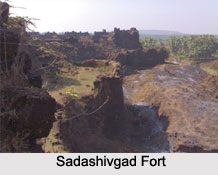 Sadashivgad Fort is an ancient Indian fortress which is located in Karwar taluka in the district of Uttara Kannada in Karnataka state. The fort is situated beside the Kali river bridge and has become a popular tourist spot at present. Sadashivgad Fort was named after the chieftain of Sonda Sadashivlingraj by his son Basavlingraj in 1715. The fortress was raised on the site of an old fortification on the northern bank of the Kali River. The old fort was dismantled and its material was utilized in the construction of Sadashivgad Fort. After the fort was erected, the village in the region was also named as Sadashivgad.
Sadashivgad Fort is an ancient Indian fortress which is located in Karwar taluka in the district of Uttara Kannada in Karnataka state. The fort is situated beside the Kali river bridge and has become a popular tourist spot at present. Sadashivgad Fort was named after the chieftain of Sonda Sadashivlingraj by his son Basavlingraj in 1715. The fortress was raised on the site of an old fortification on the northern bank of the Kali River. The old fort was dismantled and its material was utilized in the construction of Sadashivgad Fort. After the fort was erected, the village in the region was also named as Sadashivgad.
History of Sadashivgad Fort
A trading centre was developed on the brook at the mouth of the Kali River. After the establishment of Sadashivgad Fort, the trading center gained more prominence. Thus the Portuguese began to take advantage of its harbour. Later a British trading company named the Courteen Association set up a factory at Karwar in 1638. The major commodities that were purchased included muslin, cardamom, pepper, coarse blue cotton cloth and other items. Later the Courteen Association was merged with the British East India Company in 1649. Karwar was located almost 50 miles towards the south east of Goa. It gained popularity because of it safe and sheltered harbour.
In 1665 Chhatrapati Shivaji Maharaj captured Ankola Taluka and then went to Karwar. As a result, the ruler of Bijapur, Sher Shah, and the British East India Company became worried at this sudden development. They acknowledged the authority of Shivaji and offered a huge amount to him. The great Maratha Emperor Shivaji then went across the Kali River and seized Sadashivgad Fort. He founded a temple there and installed an idol of Shantadurga Devi. The local residents were entrusted with the worship of the deity and the maintenance of the temple.
The factory at Karwar was shut down in 1720 due to the opposition from the ruler of Sonda. The factory was eventually re-established in 1750. Meanwhile, a conflict arose between the Raja of Sonda and the Portuguese as the ruler favoured the English East India Company. The Sonda Fort and Sadashivgad Fort were occupied by the Portuguese forces in May 1752. However, these were ceded after the restoration of peace. The Portuguese were permitted to construct a fortress in the port town of Bhatkal in Uttara Kannada district. Moreover, the Portuguese gained dominance on the trade in Karwar and forced for the withdrawal the British Resident from the region.
The fort was later occupied by Tipu Sultan, the ruler of Mysore, in 1793. However after the death of Tipu Sultan in the Battle of Seringapatam, the British East India Company seized control over Sadashivgad Fort in 1799.
Architecture of Sadashivgad Fort
Sadashivgad Fort was erected on the north bank of Kali River. The structure consisted of 8 m high walls and ramparts. The ramparts had a width of 2 m at the top. There were also towers, bastions and battlements for firearms. The citadel inside the fortress was set up at the highest point and comprised on a single arched gate. There was also a subsidiary defense structure towards the west on outside of the main fortified area. This structure was known as the Pani Killa and was located at the base of the cliff near the sea. There was another defensive structure on the eastern slope outside the fort.
Towards the east of Sadashivgad Fort, there was the smaller fortress of Samvargad on the top of a hillock. It served as a satellite fort that was used for the protection of the main fortress. There is also a Dargah in the area that was built in the 17th century Dargah.
Present Condition of Sadashivgad Fort
Currently, most of the fort lies in ruins as a major portion of the structure was damaged by General Matthews of the British East India Company in 1783. The Shantadurga Temple is still present on top of the Sadashivagad hill. The site offers a magnificent and panoramic view of the Arabian Sea. The villages of Shiveshvar and Karwar are located near the ruined fortress of Sadashivgad.
Sadashivgad Fort is now a popular tourist destination and tracts several visitors from across the country.



















